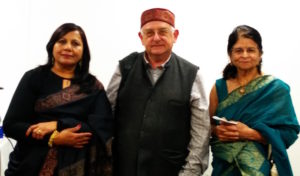Hindi teaching at Australian National University, Canberra

Rekha Rajvanshi and Dr. Shailja Chaturvedi with Professor Peter Friendlander
Hindi in Australia ”“ Part 1
Present & Future of Hindi Language at ANU
By Rekha Rajvanshi
Hindi is second most spoken language of the world. More than 490 million people around the world speak Hindi. The campaigners all around the world have once again called for Hindi to be made national language of India. In Australia, Hindi stands at seventh place in the list of most spoken languages according to 2016 census. Hindi language learning is offered in two Universities and a few public schools in Australia.
Younger generation in India and overseas is moving away from Hindi for many reasons. First of all medium of Higher education is English. The perception being that if students are not fluent in English they will miss out on a global perspective. Secondly Hindi is being ignored as English has become a status symbol. Thirdly we don’t take pride in speaking our languages like the Chinese, the Japanese and the French people do. And finally India has so many regional languages, with its people in favour of promoting their own languages and mother tongues. According to a report published in New York Times 2017, linguist say that half of 7000 languages spoken currently will disappear by the end of this century. Amongst them some of the Australian Aboriginal language are also endangered.

I spoke with Professor Friedlander, Associate Professor who is the Deputy Director ”“ Languages, School of Culture History and Languages, ANU.
Q. Professor Friedlander, can you please tell us about Hindi teaching at ANU.
Peter Friendlander: The situation of Hindi at ANU is challenging as due to the need to respond to the COVID-19 Virus all teaching has had to be shifted online. However, Hindi and Sanskrit are amongst a number of less commonly taught languages which have already been taught online now for a number of years so it has not been a sudden challenge for Hindi to move over to being only taught online. All our on campus students have now joined in with their online fellow students and they are now studying together. This year we were also fortunate to be joined by a new colleague Chris Diamond who finished his PhD on the great Maithili poet Vidyapati in December last year in Seattle at the University of Washington. This has meant that Chris, Rina and I have been working together delivering the online Hindi classes for ANU this year. We have all noticed that the stresses and strains produced by the current situation have impacted on all the students. However, we hope that our provision of a supportive learning environment for the Hindi classes has helped students studying Hindi with us to find a way forward at this difficult time.
Q. Could you elaborate how Hindi learning and teaching is different in India and here in Australia? And the challenges you have thus faced”¦
Peter Friendlander: The differences between Hindi education in universities inside and outside of India are partly linked to the different cohorts of students and their expectations. Internationally university students studying Hindi around the world normally come from a mix of heritage speakers of South Asian languages and students from non South Asian background. Due to this university level Hindi teaching internationally engages with how South Asian Heritage learners are exploring their cultural heritage and Non-South Asian background students are discovering Indian language and culture. The challenge is to make international Hindi education meaningful for this diverse cohort of students and allow them to see how learning Hindi language and about Hindi literature and Indian culture can form part of how they see themselves in the world and the relationship between India and the world. As far as I know from my connections with India, the situation there is somewhat different because many students are already Hindi speakers, or speakers of other Indian languages. My impression is that due to this university level Hindi education in Hindi is more focused on exploring how Hindi allows students to explore their cultural heritage and the relationship between the cultures of the Hindi speaking areas and other cultural traditions in India. In the end though perhaps what is common is most important of all, students, in India, or anywhere in the world, are studying as they want to understand themselves and their relationship to the world around them.
Q. How has Covid-19 impacted Hindi teaching?
Peter Friendlander: This year, more than ever, I have a sense that we should be trying to help students through their study of Hindi, explore the immense diversity of cultures in South Asia. At a time when the COVID 19 situation has made it harder for people to get together and share with each other we need to try to show our students how we can all benefit from communicating with each other and learn from each other’s traditions.
Q. How does learning language help in learning about India and its culture, and promoting ties between two nations?
Peter Friendlander: This year teaching third year Hindi we have been reading modern Hindi short stories together, such as Gyanranjan’s ”˜This side and that side of the Fence’ through which students have been able to see how young people in the nineteen sixties negotiated the relationship between traditional family relationships and new patterns of family relationships emerging as India developed. We’ve also looked as ways which Hindi satirical stories, such as Harishankar Parsai’s Inspector Matadeen on the Moon, allow us to see how Hindi has been a voice arguing for social reform and justice. Moreover, this year in a new introduction into our third year Hindi syllabus, I have been getting students to read multiple versions of stories from the Ramayana and Mahabharata. The students have really enjoyed from this. Seeing the way that every different version they read of these classics, reveals new aspects and dimensions of Indian cultural traditions and how these have been understood by Hindi authors over the last century or more. It is my hope that going forward as we learn to live in a world coming to terms with the COVID 19 in the future Hindi education can continue to play a vital role in how students can discover their own identities and learning Hindi language can allow them to learn of the great diversity and richness of Indian cultural traditions.
Short URL: https://indiandownunder.com.au/?p=15476
